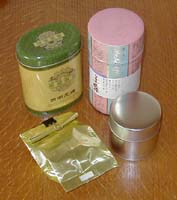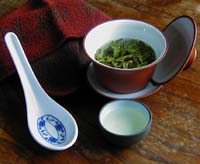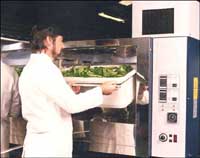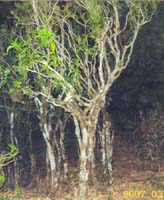The other day I realized that I’d been drinking the Dragonwell (aka Longjing) tea from the same source for years. Dragonwell isn’t my very most favorite tea, but in some circles it’s probably considered unconscionable that someone calling themselves a tea geek would only have a single version of Dragonwell in his experience. After all, it’s the most famous and sought after tea in China, right? So I set out to expand my mental picture of Dragonwell.
I started by going to six tea shops and buying an ounce of their best Dragonwell. Really, I went to more shops than that, but some didn’t have Dragonwell for sale, others only sold pre-packaged amounts of several ounces, etc. I also tried to get a little extra information if I could about the tea and what made it special. No probing questions or anything, I just let the shop give their Dragonwell pitch.
Then the photo shoot. I won’t go into this too much, but let’s just say I’m not a photographer, my camera is clunky, I couldn’t find enough light, and it was tough getting photos of the teas that actually made them look *different* from one another. However, there are pictures with each below–click to enlarge so you can get better detail.
Oh, and I “randomized” them by putting them in order of my purchases. Strangely enough, the dry leaf color alternated between dark and light green without fail when put in this order. While it won’t necessarily keep me from knowing where they came from while I’m tasting, hopefully it will minimize any prejudicing of my opinions.
And now for the tasting, with input from my partner, Loren. Each tea was brewed for 2 minutes in a gaiwan with the same temperature water (the lowest “green tea” setting on our variable-temperature electric kettle):
Sample A:
 Looking at the leaves as they brewed, we both noticed almost all broken leaves and a few stems. Leaves seemed to be of various sizes, from large (by green tea standards) to tiny. My first impression of the smell was “bitter” (odd, since you can’t smell bitter) and Loren’s was fireworks or actual gunpowder. We both noticed the scent faded to sweet, though. The flavor was a basically standard nutty “Dragonwell” flavor, with a fairly noticeable astringency. We could tell it could easily turn bitter. Kind of like walnuts…nutty with an edge of bitterness to them. Loren thought it was obviously not the highest possible quality.
Looking at the leaves as they brewed, we both noticed almost all broken leaves and a few stems. Leaves seemed to be of various sizes, from large (by green tea standards) to tiny. My first impression of the smell was “bitter” (odd, since you can’t smell bitter) and Loren’s was fireworks or actual gunpowder. We both noticed the scent faded to sweet, though. The flavor was a basically standard nutty “Dragonwell” flavor, with a fairly noticeable astringency. We could tell it could easily turn bitter. Kind of like walnuts…nutty with an edge of bitterness to them. Loren thought it was obviously not the highest possible quality.
Sample B:
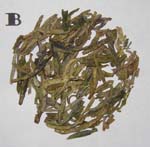 The brewing leaves seemed more uniform in size, but with a goodly number of broken pieces. It was also more uniform in color…all in the yellow-green to bright green neighborhood. The scent was lighter but sweeter than Sample A, and a bit more herbaceous. The scent was appetizing and fresh…a little like fresh veggies being steamed or something. Loren’s first taste impression was chocolate, which we narrowed down to an agreement on cacao beans as opposed to sweetened chocolate bar…a darker, richer flavor, anyhow. A little bit of astringency, but not as much as Sample A. Spent leaves looked more like a single harvest from the same place, whereas Sample A seemed like it might have been a blend of harvests.
The brewing leaves seemed more uniform in size, but with a goodly number of broken pieces. It was also more uniform in color…all in the yellow-green to bright green neighborhood. The scent was lighter but sweeter than Sample A, and a bit more herbaceous. The scent was appetizing and fresh…a little like fresh veggies being steamed or something. Loren’s first taste impression was chocolate, which we narrowed down to an agreement on cacao beans as opposed to sweetened chocolate bar…a darker, richer flavor, anyhow. A little bit of astringency, but not as much as Sample A. Spent leaves looked more like a single harvest from the same place, whereas Sample A seemed like it might have been a blend of harvests.
Sample C:
 The leaves looked like tiny pea pods, and many of them stood on end in the bottom of the gaiwan. All very even in color size and shape. It was mostly individual leaves–not just buds or leaf and budsets. Loren proclaimed it the highest quality one just looking at the leaves brewing. The smell was very fresh and clean–like a spring breeze, with a hint of spicy or chocolate. I got a flavor of like a winter squash or something, but Loren didn’t think so. But it was by far the strongest in flavor of all of them. It seemed like you could gongfu this forever and keep getting things out of it. (After we were done, we had more of this brewed for only one minute and it was kind of spicy in flavor–like nutmeg or cinnamon, but not as intense in flavor.) The leaf color of the spent leaves were, as Loren put it, “very pleasing.”
The leaves looked like tiny pea pods, and many of them stood on end in the bottom of the gaiwan. All very even in color size and shape. It was mostly individual leaves–not just buds or leaf and budsets. Loren proclaimed it the highest quality one just looking at the leaves brewing. The smell was very fresh and clean–like a spring breeze, with a hint of spicy or chocolate. I got a flavor of like a winter squash or something, but Loren didn’t think so. But it was by far the strongest in flavor of all of them. It seemed like you could gongfu this forever and keep getting things out of it. (After we were done, we had more of this brewed for only one minute and it was kind of spicy in flavor–like nutmeg or cinnamon, but not as intense in flavor.) The leaf color of the spent leaves were, as Loren put it, “very pleasing.”
Sample D:
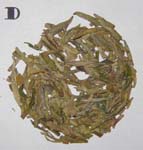 Again, more variation in leaf size and including pieces. We both got a baking/toasted scent off of it soon after adding water. (Maybe extra heat applied during processing?) This one had more bud-and-leaf combos than the rest. The baking scent continued through the scent cups as well. The flavor was much lighter, but smooth…it struck me as being like a genmaicha in taste, only without the marine-like flavor that’s common to the sencha or bancha in the genmaicha blends. Maybe if you made genmaicha using Dragonwell instead of sencha. My impression was that Sample D was very pleasant, but that it wouldn’t go as far as Sample C in a gongfu session.
Again, more variation in leaf size and including pieces. We both got a baking/toasted scent off of it soon after adding water. (Maybe extra heat applied during processing?) This one had more bud-and-leaf combos than the rest. The baking scent continued through the scent cups as well. The flavor was much lighter, but smooth…it struck me as being like a genmaicha in taste, only without the marine-like flavor that’s common to the sencha or bancha in the genmaicha blends. Maybe if you made genmaicha using Dragonwell instead of sencha. My impression was that Sample D was very pleasant, but that it wouldn’t go as far as Sample C in a gongfu session.
Sample E:
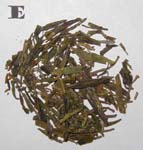 While brewing, this seemed a little similar to Sample A–some larger variation in leaf size and with pieces and stems. Loren kept smelling it and saying, “weedy.” The brew was a little yellower than the others. The smell in the scent cup was very light…not nearly as robust. However, the taste of it had a very nice sweetness in the back of the mouth/soft palate/nose. This was probably the sweetest of the lot…light and subtle, but sweet. Loren didn’t find it very distinguished in flavor, though. I kinda liked it. But we both agreed it was better in flavor than in aroma.
While brewing, this seemed a little similar to Sample A–some larger variation in leaf size and with pieces and stems. Loren kept smelling it and saying, “weedy.” The brew was a little yellower than the others. The smell in the scent cup was very light…not nearly as robust. However, the taste of it had a very nice sweetness in the back of the mouth/soft palate/nose. This was probably the sweetest of the lot…light and subtle, but sweet. Loren didn’t find it very distinguished in flavor, though. I kinda liked it. But we both agreed it was better in flavor than in aroma.
Sample F:
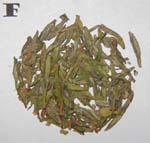 Leaf size was fairly uniform, with a few (but not many) broken pieces, with color in the cheery yellow-green to greenish-brown range with the occasional dark brown bit. The scent of the wet leaf was kind of confusing–neither of us could put our finger on it, but we both recognized that it was different from the rest. Again, very little aroma in the fragrance cup, but the flavor was interesting. It was still Dragonwell, but leaning strongly towards the marine. Not as much as a sencha, but moving in that direction. This had very little sense of where bitterness would come from. Fresh, smooth, and sweet…a nice balance of elements with the added interest factor of the hints of marine.
Leaf size was fairly uniform, with a few (but not many) broken pieces, with color in the cheery yellow-green to greenish-brown range with the occasional dark brown bit. The scent of the wet leaf was kind of confusing–neither of us could put our finger on it, but we both recognized that it was different from the rest. Again, very little aroma in the fragrance cup, but the flavor was interesting. It was still Dragonwell, but leaning strongly towards the marine. Not as much as a sencha, but moving in that direction. This had very little sense of where bitterness would come from. Fresh, smooth, and sweet…a nice balance of elements with the added interest factor of the hints of marine.
And a bit more information:
- Sample A was $2.25/oz
- Sample B was $2.75/oz and was said to be a Xi Hu (West Lake) Dragonwell
- Sample C was $21.88/oz and was said to be a competition-grade Dragonwell
- Sample D was $6.00/oz
- Sample E was $8.40/oz
- Sample F was $14.97/oz and was also said to be a Xi Hu Dragonwell.
And perhaps not surprisingly, Loren and I both both picked out the most expensive one as a top tea. Loren picked Sample F as practically a tie for him. I liked D, E, and F for different reasons, so taken all together I’ll give C the gold, F the silver, E the bronze, and D will get the “most bang for your buck” award.
If you’d like to try any of these, email me at teageek (at) teageek.net and I’ll see if I can’t get you some!
